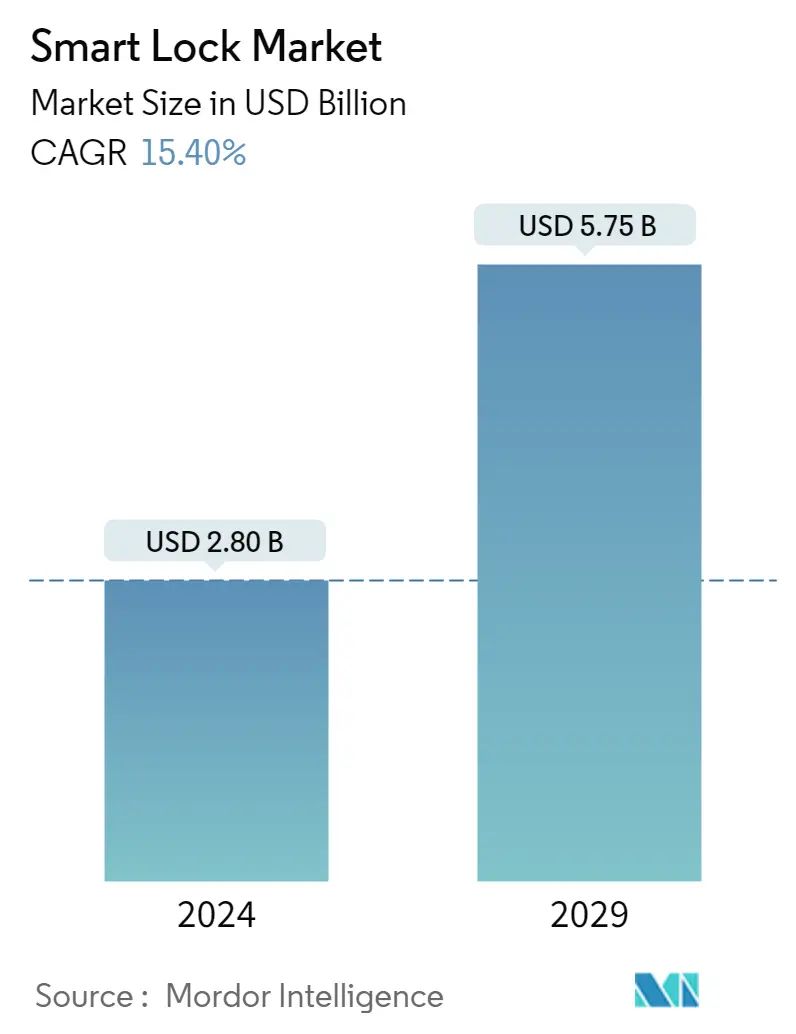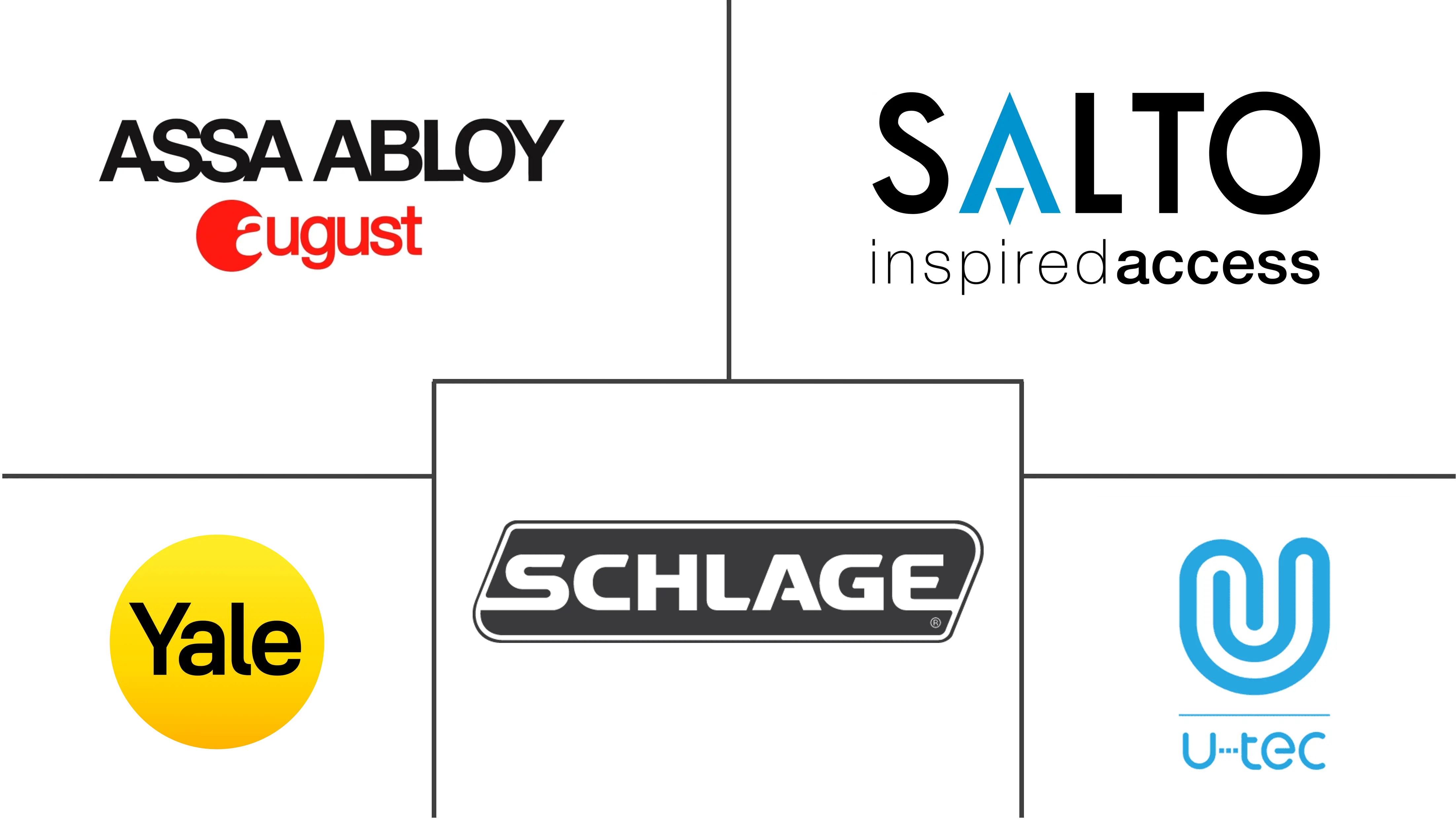Market Size of Smart Lock Industry

| Study Period | 2022 - 2029 |
| Market Size (2024) | USD 2.80 Billion |
| Market Size (2029) | USD 5.75 Billion |
| CAGR (2024 - 2029) | 15.40 % |
| Fastest Growing Market | Asia Pacific |
| Largest Market | North America |
Major Players
*Disclaimer: Major Players sorted in no particular order |
Smart Lock Market Analysis
The Smart Lock Market size is estimated at USD 2.80 billion in 2024, and is expected to reach USD 5.75 billion by 2029, growing at a CAGR of 15.40% during the forecast period (2024-2029).
The increasing adoption of smart home architecture worldwide, including features like remote access, voice control, and seamless connectivity, is further propelling the adoption of smart locks for residential premises. Additionally, the eliminated need to carry the mechanical keys around has attracted the likes of residential owners.
- The expansion of smart home adoption on a global scale and the rise of businesses that offer home automation technology are further factors in the rising demand for smart locks. The industry's participants concentrate on developing cutting-edge techniques and commercially viable goods, such as remote locking and opening windows, doors, and doors.
- Additionally, manufacturers pair their products with such devices as the number of households with voice assistants increases steadily, enabling voice control of locks. Customers are anticipated to become more popular due to these advancements as they increasingly look for sophisticated and straightforward locking/unlocking solutions. A growing number of properties must be identified and certified, including individual homes, hotels, supermarkets, banks, financial institutions, corporate buildings, and commercial buildings.
- The increasing penetration of smartphones is also stimulating the growth of connected devices, which enable users to remotely access their door locks and unlock the doors using various related mobile apps. According to Oberlo, an e-commerce company, there are currently 3.5 billion smartphone users worldwide, and the penetration rate is approximately 45.4% of the global population of 7.7 billion people. Simply put, four out of every ten people in the world are currently equipped with a smartphone.
- Amid various driving factors, the growth of the smart locks market could face challenges, owing to the prevailing vulnerability to hacking and increasing threats of cybercrimes, as smart locks, in particular, is a popular target for cybercriminals. For instance, in July this year, According to security researchers with NCC Group, there were 11 security problems affecting Nuki intelligent lock systems, including ones that could let intruders unlock doors. Such instances instill a sense of insecurity among casual users.
- The COVID-19 pandemic has led to a nosedive in investments in the ICT industry, particularly in the Internet of Things, 5G technologies, and other emerging technologies. Players in the smart lock market are forced to restrict their operational expenses. They have witnessed a reduction in hiring and capital budgets as well. Moreover, discretionary consumer spending in this scenario has also lowered the sales of smart locks. The scenario for this market looks bleak, and it is expected to witness a slowdown, which is projected to continue until the second quarter of the last year.
Smart Lock Industry Segmentation
A smart lock is an electromechanical locking device that enables users in various industries to remotely access and unlock the lock to enter the premises. It can be accessed by connecting it to smartphones and other smart devices through various communication technologies like Wi-Fi, Bluetooth, Zigbee, or Z-Wave. It allows remote authentication to verified and authorized users.
The Smart Lock Market is Segmented By Communication Technology (Wi-Fi, Bluetooth, Zigbee, Z-Wave), Authentication Methods (Biometric, Pin Code, RFID Cards), End-user Applications (Commercial, Residential, Educational Institutes & Government, Industrial), and Geography (North America, Europe, Asia-Pacific, and Rest of the World).
The market sizes and forecasts are provided in terms of value (USD million) for all the above segments.
| Communication Technology | |
| Wi-Fi | |
| Bluetooth | |
| Zigbee | |
| Z-Wave |
| Authentication Method | |
| Biometric | |
| Pin Code | |
| RFID Cards |
| End-user Application | |
| Commercial | |
| Educational Institutions & Government | |
| Industrial |
| Geography | |
| Europe | |
| Asia Pacific | |
| North America | |
| Rest of the World |
Smart Lock Market Size Summary
The smart lock market is poised for significant growth, driven by the increasing adoption of smart home technologies and the demand for enhanced security solutions. As more consumers embrace features like remote access, voice control, and seamless connectivity, smart locks are becoming a popular choice for residential and commercial properties. The convenience of not needing to carry mechanical keys and the ability to control locks via smartphones and voice assistants are key factors fueling this trend. The market is also seeing a rise in demand from the hospitality sector, where hotels are adopting smart locks to improve security and customer experience. Despite the promising growth prospects, the market faces challenges such as cybersecurity threats and the need for robust security measures to protect against hacking.
The smart lock industry is characterized by innovation and the introduction of advanced products aimed at enhancing security and convenience. Key players are focusing on developing solutions that integrate with existing smart home systems and offer features like remote locking and unlocking, biometric access, and mobile app control. The market is still in its early stages, with varying adoption rates across regions, presenting opportunities for expansion, particularly in the United States and Europe. Regulatory support and increasing consumer awareness about security are expected to further drive market growth. As the industry evolves, companies are investing in research and development to stay competitive and meet the growing demand for smart locking solutions in both residential and commercial sectors.
Smart Lock Market Size - Table of Contents
-
1. MARKET DYNAMICS
-
1.1 Market Overview
-
1.2 Industry Attractiveness - Porter's Five Forces Analysis
-
1.2.1 Bargaining Power of Suppliers
-
1.2.2 Bargaining Power of Buyers
-
1.2.3 Threat of New Entrants
-
1.2.4 Threat of Substitutes
-
1.2.5 Intensity of Competitive Rivalry
-
-
1.3 Industry Value Chain Analysis
-
1.4 Market Drivers
-
1.4.1 Increasing Safety and Security Concerns
-
1.4.2 Increasing Adoption of Smart Home Architecture
-
-
1.5 Market Challenges
-
1.5.1 Increasing Cyber Security and Hacking Threats
-
-
-
2. MARKET SEGMENTATION
-
2.1 Communication Technology
-
2.1.1 Wi-Fi
-
2.1.2 Bluetooth
-
2.1.3 Zigbee
-
2.1.4 Z-Wave
-
-
2.2 Authentication Method
-
2.2.1 Biometric
-
2.2.2 Pin Code
-
2.2.3 RFID Cards
-
-
2.3 End-user Application
-
2.3.1 Commercial
-
2.3.2 Educational Institutions & Government
-
2.3.3 Industrial
-
-
2.4 Geography
-
2.4.1 Europe
-
2.4.2 Asia Pacific
-
2.4.3 North America
-
2.4.4 Rest of the World
-
-
Smart Lock Market Size FAQs
How big is the Smart Lock Market?
The Smart Lock Market size is expected to reach USD 2.80 billion in 2024 and grow at a CAGR of 15.40% to reach USD 5.75 billion by 2029.
What is the current Smart Lock Market size?
In 2024, the Smart Lock Market size is expected to reach USD 2.80 billion.

